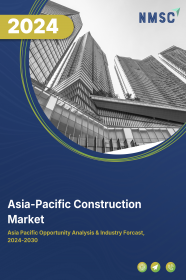
Latin America Construction Market by Type (Renovation and New Construction), and by Sector (Real Estate, Infrastructure, and Industrial)–Opportunity Analysis and Industry Forecast, 2024–2030
Industry: Construction & Manufacturing | Publish Date: 07-Jan-2025 | No of Pages: 155 | No. of Tables: 119 | No. of Figures: 64 | Format: PDF | Report Code : CM2225
Latin America Construction Market Overview
The Latin America Construction Market size was valued at USD 415.21 billion in 2023, and is predicted to reach USD 514.29 billion by 2030, at a CAGR of 1.7% from 2024 to 2030.
The construction market, encompassing infrastructure market, is vital to the economy, managing the entire lifecycle of diverse physical structures including infrastructure, buildings, and facilities. This industry undertakes a wide range of projects, from residential, commercial, and industrial developments to civil engineering and institutional infrastructure ventures.
Collaboration among numerous stakeholders, such as architects, engineers, contractors, suppliers, developers, investors, and government agencies, is essential for its operation. Positioned for growth, the industry is being driven by an increased focus on environmentally sustainable practices, such as the use of green building materials and energy-efficient designs. Additionally, factors such as rising per capita income in emerging economies and low-interest rates in developed nations are expected to further fuel the expansion of the infrastructure market.
Diverse Project Scope and Stakeholder Collaboration Boosts the Construction Market Growth
The construction market, encompassing both real estate and infrastructure, is crucial to the economy, managing the entire lifecycle of diverse physical structures, including buildings and facilities. This industry undertakes a wide range of projects, from residential, commercial, and industrial developments to civil engineering and institutional infrastructure ventures. Collaboration among numerous stakeholders—such as architects, engineers, contractors, suppliers, developers, investors, and government agencies are essential for infrastructure market operation.
Sustainability and Economic Factors Propels the Construction Market Growth
The construction market is positioned for growth, driven by an increased focus on environmentally sustainable practices, such as the use of green building materials and energy-efficient designs. Additionally, factors such as rising per capita income in emerging economies and low-interest rates in developed nations are expected to further fuel the expansion of the infrastructure market. These trends highlight the industry's adaptability and responsiveness to both environmental and economic changes.
Regulatory Complexities Hindering Construction Market Growth
Navigating regulatory complexities presents a significant challenge in the construction market. Infrastructure projects often face hurdles due to the intricate network of government regulations and permitting procedures. Infrastructure initiatives require numerous permits and approvals from governmental bodies at local, regional, and national levels.
These mandates include adherence to zoning regulations, environmental assessments, compliance with building codes, safety standards, and various other regulatory requirements. Lengthy permit acquisition processes, bureaucratic inefficiencies, and regulatory disparities among different jurisdictions can significantly prolong project timelines and inflate costs. Moreover, fluctuations in regulations or unexpected policy changes can disrupt ongoing projects and deter potential investments in infrastructure market.
Integration of Digitalization and BIM Presents Lucrative Opportunity for Market Expansion
The construction market in Latin America is undergoing a significant transformation with the integration of digitalization and the adoption of Building Information Modeling (BIM). Advanced technologies such as BIM are enhancing efficiency, accuracy, and collaboration across diverse projects.
BIM, a sophisticated 3D modeling tool, enables stakeholders to generate and manage digital representations of structures and infrastructure, facilitating improved coordination and communication among project teams. For instance, in September 2022, the National Institute of Building Sciences (NIBS) launched the Latin America National Building Information Management (BIM) Program.
This initiative aims to revolutionize the infrastructure market, achieving unprecedented levels of industrial efficiency through digitalization. By addressing the inadequacy of digitalization within the Thai infrastructure sector, the program seeks to streamline lifecycle work processes, enhancing efficiency, cost-effectiveness, resilience, and safety for infrastructure and maintenance projects.
Competitive Landscape
The market players operating in the Latin America construction market include OCamargo Correa Construction Company, Techint Engineering & Construction, Sudamericana Construction Company SA, Criba Construcciones, SalfaCorp SA, Besalco, Odebrecht, Sigdo Koppers S.A., Constructora MECO S.A, Echeverria Izquierdo, OEC, ICA, IDEAL, S.A.B. de C.V., Cyrela Urbanismo, Andrade Gutierrez, and others.
Latin America Construction Market Key Segments
By Type
-
Renovation
-
New Construction
By Sector
-
Real Estate
-
Residential
-
Affordable
-
Luxury
-
-
Commercial
-
Retail Buildings
-
Office Buildings
-
Hospitality
-
Healthcare Facilities
-
Educational Institutes
-
Entertainment Ventures
-
-
-
Infrastructure
-
Transportation
-
Airport
-
Port
-
Rail
-
Road
-
-
Water and Wastewater
-
Energy
-
Telecommunication
-
-
Industrial
-
Manufacturing Plant
-
Warehouses
-
Power Plants
-
Oil Refineries
-
Chemical Plants
-
Key players
-
Camargo Correa Construction Company
-
Techint Engineering & Construction
-
Sudamericana Construction Company SA
-
Criba Construcciones
-
SalfaCorp SA
-
Besalco
-
Odebrecht
-
Sigdo Koppers S.A.
-
Constructora MECO S.A
-
Echeverria Izquierdo
-
OEC
-
ICA
-
IDEAL, S.A.B. de C.V.
-
Cyrela Urbanismo
-
Andrade Gutierrez
REPORT SCOPE AND SEGMENTATION:
|
Parameters |
Details |
|
Market Size in 2023 |
USD 415.21 Billion |
|
Revenue Forecast in 2030 |
USD 514.29 Billion |
|
Growth Rate |
CAGR of 1.7% from 2024 to 2030 |
|
Analysis Period |
2023–2030 |
|
Base Year Considered |
2023 |
|
Forecast Period |
2024–2030 |
|
Market Size Estimation |
Billion (USD) |
|
Growth Factors |
|
|
Companies Profiled |
10 |
|
Market Share |
Available for 10 companies |
|
Customization Scope |
Free customization (equivalent up to 80 working hours of analysts) after purchase. Addition or alteration to country, regional, and segment scope. |
|
Pricing and Purchase Options |
Avail customized purchase options to meet your exact research needs. |

















 Speak to Our Analyst
Speak to Our Analyst

















